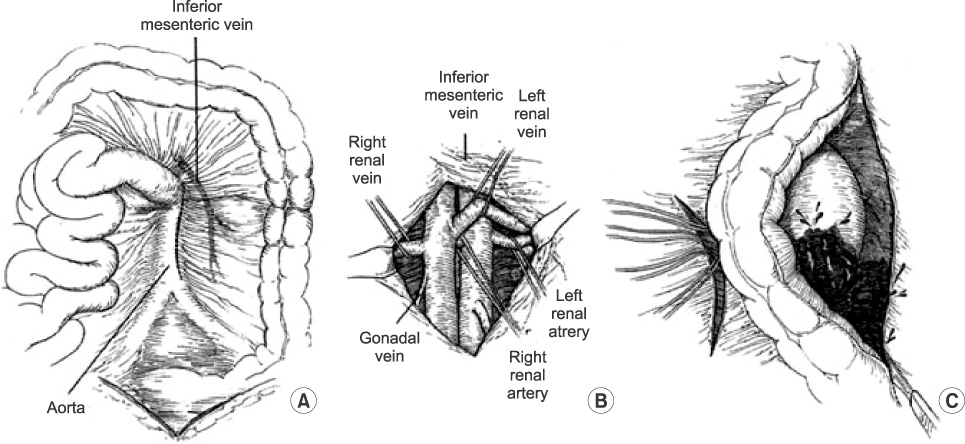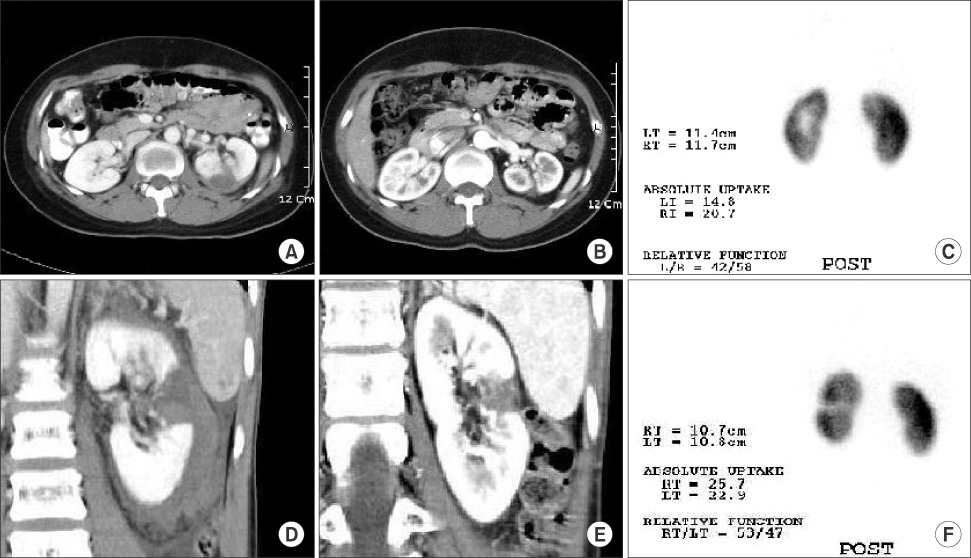Korean J Urol.
2007 Sep;48(9):885-896. 10.4111/kju.2007.48.9.885.
Treatment of Renal Injury: Practical Approach
- Affiliations
-
- 1Department of Urology, National Medical Center, Seoul, Korea. nmcuro@hanmail.net
- KMID: 2061287
- DOI: http://doi.org/10.4111/kju.2007.48.9.885
Abstract
- Traumatic injuries are the leading cause of death in young people, and the renal injury is one of the major abdominal trauma. Hematuria is the most common sign of renal trauma, however the degree of hematuria and the severity of renal injury do not correlate consistently. Criteria for radiographic investigation is somewhat different according to the injury mechanism and an age. Excellent imaging modality such as computerized tomograph has made it possible to delineate not only detailed anatomic configuration for renal laceration itself but the presence of associated intra- abdominal organ injury. Renal injury may be presented as one of the multiple trauma, thus full evaluation for the overall injury severity of the patient is mandatory. Advanced supportive care techniques and awareness of the kidney's capacity for healing have facilitated non-operative management. Nowadays, operative exploration is indicated only in selected patients with major renal injury even in the patients with penetrating trauma, and high rates of renal reconstruction is possible through early vascular control. Urologic surgeon, as a major member of the trauma team, should be expertized in the surgical skills for reconstruction as well as acquiring up-to-date knowledge on diagnosis and management of renal trauma.
Keyword
Figure
Cited by 1 articles
-
Scintigraphic Assessment of Renal Function Using 99mTc-DTPA in Miniature Pigs with Unilateral Ureteral Obstruction
Se Eun Kim, Kyung Mi Shim, Won Guk Lee, Seok Hwa Choi, Soo Hyun Park, Ho Jae Han, Seong Soo Kang
Lab Anim Res. 2010;26(1):103-108. doi: 10.5625/lar.2010.26.1.103.
Reference
-
1. Nash PA, Carroll PR. McAninch JW, editor. Staging of renal trauma. Traumatic and reconstructive urology. 1996. 1st ed. Philadelphia: Saunders;95–104.2. Buckley JC, McAninch JW. Selective management of isolated and nonisolated grade IV renal injuries. J Urol. 2006. 176:2498–2502.3. Altman AL, Haas C, Dinchman KH, Spirnak JP. Selective nonoperative management of blunt grade 5 renal injury. J Urol. 2000. 164:27–30.4. Smith EM, Elder JS, Spirnak JP. Major blunt renal trauma in the pediatric population: is a nonoperative approach indicated? J Urol. 1993. 149:546–548.5. McAninch JW, Santucci RA. Wein AJ, Kavoussi LR, Novick AC, Partin AW, Peters CA, editors. Renal and ureteral trauma. Campbell-Walsh urology. 2007. 9th ed. Philadelphia: Saunders;1274–1292.6. Wessells H. Evaluation and management of renal trauma in the 21st century. AUA update series. 2002. 21:234–239.7. Herschorn S, Radomski SB, Shoskes DA, Mahoney J, Hirshberg E, Klotz L. Evaluation and treatment of blunt renal trauma. J Urol. 1991. 146:274–276.8. Eastham JA, Wilson TG, Ahlering TE. Urological evaluation and management of renal proximity stab wounds. J Urol. 1993. 150:1771–1773.9. Bernath AS, Schutte H, Fernandez RR, Addonizio JC. Stab wounds of the kidney: conservative management in flank penetration. J Urol. 1983. 129:468–470.10. Kyoun JK, Cho SY, Lee JB. Renal trauma in abdominal and thoracic stab injury: comparison of incidence and degree of injury according to the stab entrance site. Korean J Urol. 2003. 44:328–333.11. Cass AS. Renovascular injuries from external trauma. Diagnosis, treatment, and outcome. Urol Clin North Am. 1989. 16:213–220.12. Wilson RF, Ziegler DW. Diagnostic and treatment problems in renal injuries. Am Surg. 1987. 53:399–402.13. Miller KS, McAninch JW. Radiographic assessment of renal trauma: our 15-year experience. J Urol. 1995. 154:352–355.14. Alsikafi NF, Rosenstein DI. Staging, evaluation, and nonoperative management of renal injuries. Urol Clin North Am. 2006. 33:13–19.15. Lee JY, Cass AS. McAninch JW, editor. Renal injuries in children. Traumatic and reconstructive urology. 1996. 1st ed. Philadelphia: Saunders;127–133.16. Buckley JC, McAninch JW. The diagnosis, management, and outcomes of pediatric renal injuries. Urol Clin North Am. 2006. 33:33–40.17. Boone TB, Gilling PJ, Husmann DA. Ureteropelvic junction disruption following blunt abdominal trauma. J Urol. 1993. 150:33–36.18. Mulligan JM, Cagiannos I, Collins JP, Millward SF. Ureteropelvic junction disruption secondary to blunt trauma: excretory phase imaging (delayed films) should help prevent a missed diagnosis. J Urol. 1998. 159:67–70.19. Al-Qudah HS, Santucci RA. Complications of renal trauma. Urol Clin North Am. 2006. 33:41–53.20. Mee SL, McAninch JW, Robinson AL, Auerbach PS, Carroll PR. Radiographic assessment of renal trauma: a 10-year prospective study of patient selection. J Urol. 1989. 141:1095–1098.21. Danuser H, Wille S, Zoscher G, Studer U. How to treat kidney ruptures: primary open surgery or conservative treatment with deferred surgery when necessary? Eur Urol. 2001. 39:9–14.22. Kim HG, Kim SJ, Kim KM, Choi H. Kidney injury in children. Korean J Urol. 1992. 33:1038–1044.23. Choi BS, Park JY, Hyun JS. Analysis of 50 cases of renal injury which occurred in the last 6 years. Korean J Urol. 1997. 38:490–495.24. Brown SL, Elder JS, Spirnak JP. Are pediatric patients more susceptible to major renal injury from blunt trauma? A comparative study. J Urol. 1998. 160:138–140.25. Lee JH, Yoon SJ, Lee JB. Comparison of blunt renal injury between children and adults: effect of the causes on severity of renal injury. Korean J Urol. 2005. 46:32–36.26. Golf CD, Collin GR. Management of renal trauma at a rural level I trauma center. Am Surg. 1998. 64:226–230.27. Matthews LA, Smith EM, Spirnak JP. Nonoperative treatment of major blunt renal lacerations with urinary extravasation. J Urol. 1997. 157:2056–2058.28. Kansas BT, Eddy MJ, Mydlo JH, Uzzo RG. Incidence and management of penetrating renal trauma in patients with multiorgan injury: extended experience at an inner city trauma center. J Urol. 2004. 172:1355–1360.29. Armenakas NA, Duckett CP, McAninch JW. Indications for nonoperative management of renal stab wounds. J Urol. 1999. 161:768–771.30. Kristjansson A, Pedersen J. Management of blunt renal trauma. Br J Urol. 1993. 72:692–696.31. Moore EE, Shackford S, Pachter HL, McAninch JW, Browner BD, Champion HR, et al. Organ injury scaling: spleen, liver, and kidney. J Trauma. 1989. 29:1664–1666.32. Ko YK. Korean Soc Trauma. Evaluation of injury severity for traumatized patients. 2005. 1:2nd ed. 21–28.33. Lavoie A, Moore L, LeSage N, Liberman M, Sampalis JS. The new injury severity score: a more accurate predictor of in-hospital mortality than the injury severity score. J Trauma. 2004. 56:1312–1320.34. Cass AS, Vieira J. Comparison of IVP and CT findings in patients with suspected severe renal injury. Urology. 1987. 29:484–487.35. Nicolaisen GS, McAninch JW, Marshall GA, Bluth RF Jr, Carroll PR. Renal trauma: re-evaluation of the indications for radiographic assessment. J Urol. 1985. 133:183–187.36. Uflacker R, Paolini RM, Lima S. Management of traumatic hematuria by selective renal artery embolization. J Urol. 1984. 132:662–667.37. Morey AF, McAninch JW, Tiller BK, Duckett CP, Carroll PR. Single shot intraoperative execretory urography for the immediate evaluation of renal trauma. J Urol. 1999. 161:1088–1092.38. McAninch JW, Carroll PR, Klosterman PW, Dixon CM, Greenblatt MN. Renal reconstruction after injury. J Urol. 1991. 145:932–937.39. Moudouni SM, Patard JJ, Manunta A, Guiraud P, Guille F, Lobel B. A conservative approach to major blunt renal lacerations with urinary extravasation and devitalized renal segments. BJU Int. 2001. 87:290–294.40. Lee CK, Ha DB, Lee KS. The clinical observation on 67 cases of renal injury by blunt trauma with conservative treatment. Korean J Urol. 2000. 41:609–614.41. Wessells H, McAninch JW, Meyer A, Bruce J. Criteria for nonoperative treatment of significant penetrating renal lacerations. J Urol. 1997. 157:24–27.42. Heyns CF, de Klerk DP, de Kock ML. Stab wounds associated with hematuria-a review of 67 cases. J Urol. 1983. 130:228–231.43. Khan AB, Reid AW. Management of renal stab wounds by arteriographic embolisation. Scand J Urol Nephrol. 1994. 28:109–110.44. Beaujeux R, Saussine C, al-Fakir A, Boudjema K, Roy C, Jacqmin D, et al. Superselective endo-vascular treatment of renal vascular lesions. J Urol. 1995. 153:14–17.45. Nash PA, Bruce JE, McAninch JW. Nephrectomy for traumatic renal injuries. J Urol. 1995. 153:609–611.46. Master VA, McAninch JW. Operative management of renal injuries: parenchymal and vascular. Urol Clin North Am. 2006. 33:21–31.47. Husmann DA, Gilling PJ, Perry MO, Morris JS, Boone TB. Major renal lacerations with a devitalized fragment following blunt abdominal trauma: a comparison between nonoperative (expectant) versus surgical management. J Urol. 1993. 150:1774–1777.48. Haas CA, Spirnak JP. Traumatic renal artery occlusion: a review of the literature. Tech Urol. 1998. 4:1–11.49. McAninch JW, Carroll PR. Renal trauma: kidney preservation through improved vascular control-a refined approach. J Trauma. 1982. 22:285–290.50. Carroll PR, Klosterman P, McAninch JW. Early vascular control for renal trauma: a critical review. J Urol. 1989. 141:826–829.51. Carroll PR, McAninch JW, Wong A, Wolf JS Jr, Newton C. Outcome after temporary vascular occlusion for the management of renal trauma. J Urol. 1994. 151:1171–1173.52. Lee JB, Hwang SG, Moon JC. Kidney preserving surgery in renal trauma: experience by early vascular approach technique. Korean J Urol. 1998. 39:972–976.53. McAninch JW, Carroll PR, Armenakas NA, Lee P. Renal gunshot wounds: methods of salvage and reconstruction. J Trauma. 1993. 35:279–284.54. McAninch JW, Carroll PR. McAninch JW, editor. Renal exploration after trauma: indications and reconstructive techniques. Traumatic and reconstructive urology. 1996. 1st ed. Philadelphia: Saunders;105–112.55. Wessells H, Deirmenjian J, McAninch JW. Preservation of renal function after reconstruction for trauma: quantitative assessment with radionuclide scintigraphy. J Urol. 1997. 157:1583–1586.56. Yoon JH, Song KH, Kim KJ. Conservative treatment of major renal injury: morphological and functional recovery. Korean J Urol. 1998. 39:149–152.57. Choi UC, Jeong HH, Lee JB, Yun JC. Preservation of renal function after conservative treatment for trauma: short-term followup results with 99m technetium dimercapto-succinic acid. Korean J Trauma. 2003. 16:25–30.58. Blankenship JC, Gavant ML, Cox CE, Chauhan RD, Gingrich JR. Importance of delayed imaging for blunt renal trauma. World J Surg. 2001. 25:1561–1564.59. Hammer CC, Santucci RA. Effect of an institutional policy nonoperative treatment of grades I to IV renal injuries. J Urol. 2003. 169:1751–1753.60. Brandes SB, McAninch JW. Taneja SS, Smith RB, Ehlich RM, editors. Complications of renal trauma. Complications of urology. 2001. 3rd ed. Philadelphia: Saunders;205–225.61. Meng MV, Mario LA, McAninch JW. Current treatment and outcomes of perinephric abscesses. J Urol. 2002. 168:1337–1340.62. Watts RA, Hoffbrand BI. Hypertension following renal trauma. J Hum Hypertens. 1987. 1:65–71.63. Cass AS, Luxenberg M, Gleich P, Smith C. Long-term results of conservative and surgical management of blunt renal lacerations. Br J Urol. 1987. 59:17–20.64. Nichol AJ, Theunissen D. Renal salvage in penetrating kidney injuries: a prospective analysis. J Trauma. 2002. 53:351–353.65. Dobrowolski Z, Kusionowicz J, Drewniak T, Habrat W, Lipczynski W, Jakubik P, et al. Renal and ureteric trauma: diagnosis and management in Poland. BJU Int. 2002. 89:748–751.66. Song KH, Lee BK, Kim KJ. A clinical evaluation of renal injury: 202 cases. Korean J Trauma. 1997. 10:39–43.67. Lee HS, Kwon KI, Yeum GY. Clinical evaluation of blunt renal trauma. Korean J Urol. 1998. 39:638–642.68. Lee JB, Park YJ, Lee JH, Kyoun JK. Propriety of computerized tomography as a primary radiographic investigation in blunt renal trauma. Korean J Trauma. 2001. 14:69–73.
- Full Text Links
- Actions
-
Cited
- CITED
-
- Close
- Share
- Similar articles
-
- A practical review of watch-and-wait approach in rectal cancer
- Non-Permanent Transcatheter Proximal Renal Artery Embolization for a Grade 5 Renal Injury with Delayed Recanalization and Preserved Renal Parenchymal Enhancement
- An Unusual Complication of Colonic Perforation Following Percutaneous Nephrostomy in a Grade IV Blunt Renal Injury Patient
- Practical utility of the three-dimensional approach in orthognathic surgery
- The clinical observation on diagnosis and treatment of renal injury



